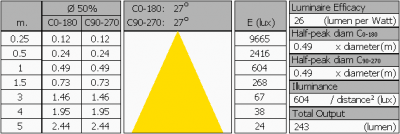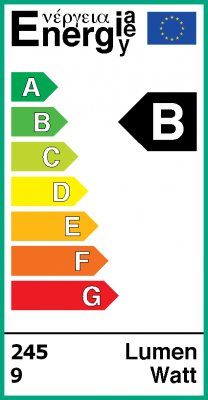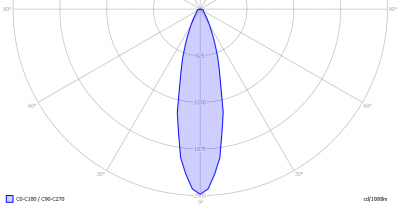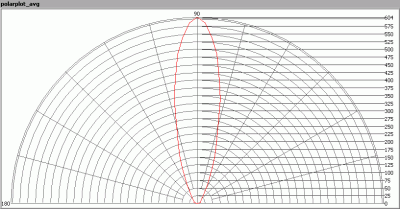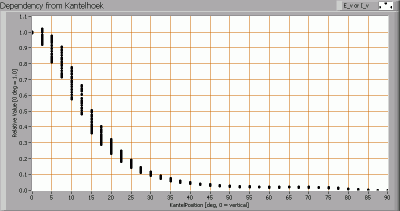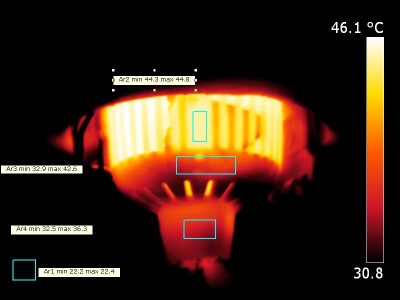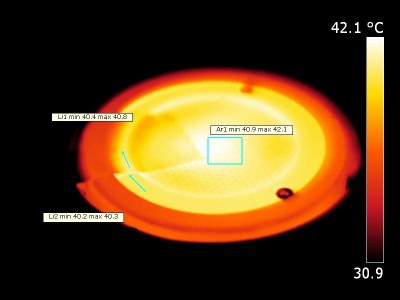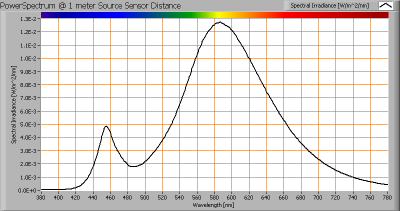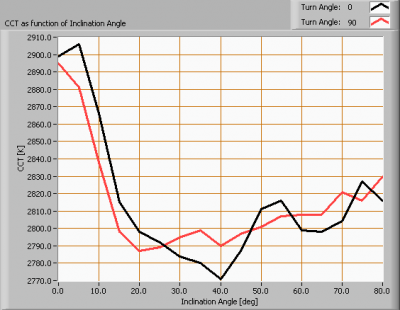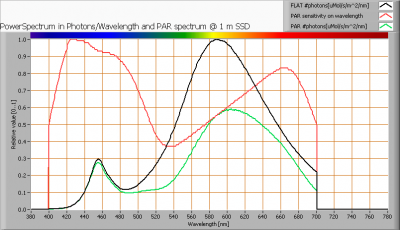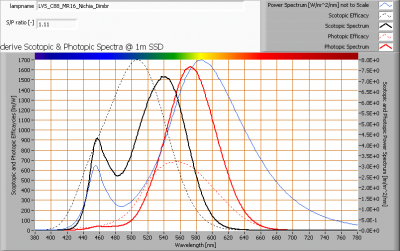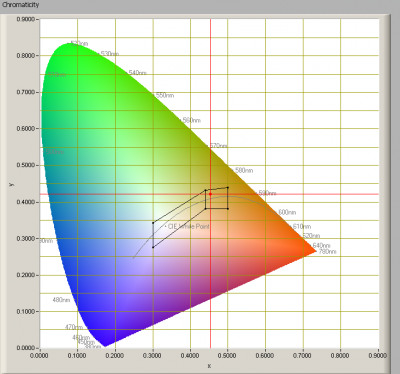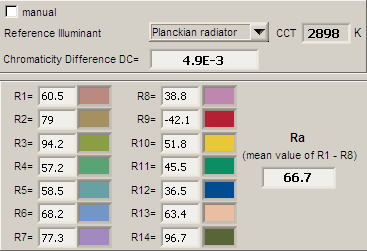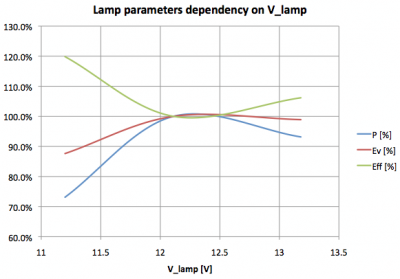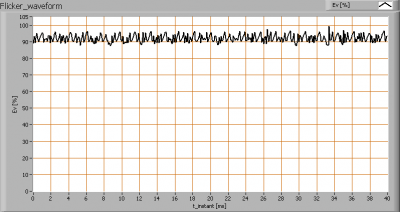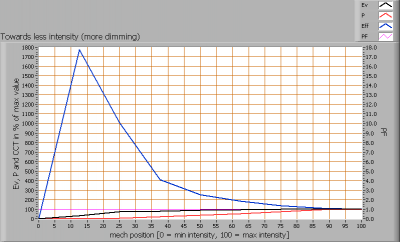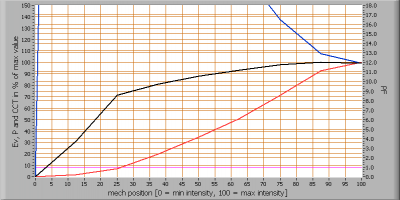Ledverlichting Soest – LVS_C88_MR16_Nichia_Dimmable
Posted by Marcel van der Steen in Led lights, Light measurements No Comments» presents an led MR16 spotlamp that emits warm white light. The lamp contains a little ventilator to effectively remove the heat and is also dimmable with help of a 12 V DC dimmer.
presents an led MR16 spotlamp that emits warm white light. The lamp contains a little ventilator to effectively remove the heat and is also dimmable with help of a 12 V DC dimmer.
This article shows the measurement results. Many parameters are also found in the Eulumdat file.
See this overview for a comparison with other light bulbs.

Summary measurement data
| parameter | meas. result | remark |
|---|---|---|
| Color temperature | 2898 K | Warm white |
| Luminous intensity Iv | 604 Cd | Measured straight underneath the lamp. |
| Illuminance modulation index | 6 % | Measured straight underneath the lamp. Is a measure for the amount of flickering. |
| Beam angle | 27 deg | 27º for all C planes as this lamp has a symmetry along the 1st axis. |
| Power P | 9.4 W | Note: the lamp current varied between 730 and 780 mA. Maybe the effect of the ventilator off anf on. At 730 mA the consumed power is 8.8 W. |
| Power Factor | n.a. | A DC power supply was used to test. This means that there is no blind power. |
| THD | n.a. % | Total Harmonic Distortion is not present due to the usage of a DC Voltage which results in a DC current. |
| Luminous flux | 243 Lm | |
| Luminous efficacy | 26 Lm/W | Note that a DC power supply has been used. This efficacy is for the led only excluding the efficacy of a power supply converting grid voltage to the voltage or current needed for the led. Normally a power supply or converter adds in-efficacy to the total system unless this lamp is to be connected to for instance a battery. |
| EU-label classification | B | The energy class, from A (more efficient) to G (least efficient). |
| CRI_Ra | 67 | Color Rendering Index. |
| Coordinates chromaticity diagram | x=0.4524 and y=0.4218 | |
| Fitting | GU5.3/MR16 | This lamp can connected to a 12 V DC or AC voltage. For this test a 12 V DC has been used. |
| PAR-value | 5.1 μMol/s/m2 | The number of photons seen by an average plant when it is lit by the light of this light bulb. Value valid at 1 m distance from light bulb. |
| PAR-photon efficacy | 0.2 μMol/s/We | The toal emitted number of photons by this light, divided by its consumption in W. It indicates a kind of efficacy in generating photons. |
| S/P ratio | 1.1 | This factor indicates the amount of times more efficient the light of this light bulb is perceived under scotopic circumstances (low environmental light level). |
| D x H external dimensions | 50 x 54 mm | External dimensions of the lamp. |
| D luminous area | 34 mm | Dimensions of the luminous area (used in Eulumdat file). This is the surface of the smallest circle around the leds. |
| General remarks | The ambient temperature during the whole set of measurements was 22.7-22.9 deg C.
The temperature of the housing gets about 22 degrees hotter than ambient temperature. Warm up effect: during the warm up time the illuminance decreases with about 6 % and the consumed power seems to increase with about 7 %, but this seems to depend on the on or off status of the ventilator. Voltage dependency: the power consumption and illuminance vary, when the power voltage varies between 200-250 V. The lamp is tested on dim-ability with help of a 12 V DC dimmer and found well dim-able. |
|
| Measurement report (PDF) | ||
| Eulumdat file |  |
Right click on icon and save the file. |
| IES file |  |
Right click on icon and save the file. |
Overview table
The overview table is explained on the OliNo website.
Please note that this overview table makes use of calculations, use this data with care as explained on the OliNo site. E (lux) values are not accurate, when within 5 x 34 mm ≈ 200 mm. Within this distance from the lamp, the measured lux values willl be less than the computed values in this overview as the measurements are then within the near field of the lamp.
EU Energy label classfication
With the measurement results of the luminous flux and the consumed power the classification on energy of this lamp is calculated. This information is requested in the EU for certain household lamps, see also the OliNo site that explains for which lamps it is requested, how the label looks like and what information it needs to contain.
Herewith the labels for this lamp in color and black and white.
EU energy label of this lamp
Label in black and white.
Eulumdat light diagram
This light diagram below comes from the program Qlumedit, that extracts these diagrams from an Eulumdat file. It is explained on the OliNo site.
The light diagram giving the radiation pattern.
It indicates the luminous intensity around the light bulb. The C0-C180 plane and C90-C270 give the same result as the lamp is semmetrical along its 1st axis.
Illuminance Ev at 1 m distance, or luminous intensity Iv
Herewith the plot of the averaged luminous intensity Iv as a function of the inclination angle with the light bulb.
The radiation pattern of the light bulb.
This radiation pattern is the average of the light output of the light diagram given earlier. Also, in this graph the luminous intensity is given in Cd.
These averaged values are used (later) to compute the lumen output.
Intensity data of every measured turn angle at each inclination angle.
This plot shows per inclination angle the intensity measurement results for each turn angle at that inclination angle. There normally are differences in illuminance values for different turn angles. However for further calculations the averaged values will be used.
When using the average values per inclination angle, the beam angle can be computed, being 27º for the C0-C180 and the C90-C270 plane.
Luminous flux
With the averaged illuminance data at 1 m distance, taken from the graph showing the averaged radiation pattern, it is possible to compute the luminous flux.
The result of this computation for this light spot is a luminous flux of 243 Lm.
Luminous efficacy
The luminous flux being 243 Lm, and the power of the light bulb being 9.4 W, yields a luminous efficacy of 26 Lm/W.
The reported efficacy is for the ledmodules only, without an eventual power supply needed to transform 230 V AC into 12 V DC. Such a power supply would normally lead to additional power consumption.
Electrical properties
The lamp was used on DC power and therefore no blind currents.
| Lamp voltage | 12.11 V DC |
| Lamp current | 0.778 A |
| Power P | 9.4 W |
| Apparent power S | n.a. VA |
| Power factor | n.a. |
Temperature measurements lamp
Side view.
The aluminum measured directly gives the same temperature value (when the IR-camera is set to 0.95 emissivity) as the reading on the masking tape on the aluminum. This means that the aluminum has about an equal emissivity, so 0.95 was taken.This means the material is well capable of emitting heat via radiation.
Besides that the lamp stays relatively cool thanks to the work of the ventilator that is build in.
Temperature image where the front is measured; the glass and the metal ring around it.
The piece of masking tape is hardly visible on the metal ring. The ring measured directly gives then a equal value than measured indirectly (via the tape) so emissivity is taken 0.95.
| status lamp | > 2 hours on |
| ambient temperature | 22 deg C |
| reflected background temperature | 22 deg C |
| camera | Flir T335 |
| emissivity | 0.95(1) |
| measurement distance | 0.2 m |
| IFOVgeometric | 0.136 mm per 0.1 m distance |
| NETD (thermal sensitivity) | 50 mK |
(1) See the text for explanation.
Color temperature and Spectral power distribution
The spectral power distribution of this light bulb, energies on y-axis valid at 1 m distance.
The measured color temperature is about 2900 K which is warm white.
This color temperature is measured straight underneath the light bulb. Below a graph showing the color temperature for different inclination angles.
Color temperature as a function of inclination angle.
The measurement of CCT is measured for inclination angles up to 80º. Beyond this angle the illuminance is very low (< 5 lux).
The beam angle is 27º, meaning a 13.5º inclination angle. In this area most of the light is present. The variation in correlated color temperature in this area is about ≈ 3 %.
PAR value and PAR spectrum
To make a statement how well the light of this light bulb is for growing plants, the PAR-area needs to be determined. See the OliNo website how this all is determined and the explanation of the graph.
The photon spectrum, then the sensitivity curve and as result the final PAR spectrum of the light of this light bulb
| parameter | value | unit |
|---|---|---|
| PAR-number | 5.1 | μMol/s/m² |
| PAR-photon current | 2.0 | μMol/s |
| PAR-photon efficacy | 0.2 | μMol/s/W |
The PAR efficiency is 62 % (valid for the PAR wave length range of 400 – 700 nm). So maximally 62 % of the total of photons in the light is effectively used by the average plant (since the plant might not take 100 % of the photons at the frequency where its relative sensitivity is 100 %).
S/P ratio
The S/P ratio and measurement is explained on the OliNo website. Here the results are given.
The power spectrum, sensitivity curves and resulting scotopic and photopic spectra (spectra energy content defined at 1 m distance).
The S/P ratio is 1.1.
More info on S/P ratio can be found on the OliNo website.
Chromaticity diagram
The chromaticity space and the position of the lamp’s color coordinates in it.
The light coming from this lamp is inside the area of class B. This is an area defined for signal lamps, see also the OliNo website.
Its coordinates are x=0.4524 and y=0.4218.
Color Rendering Index (CRI) or also Ra
Herewith the image showing the CRI as well as how well different colors are represented (rendered). The higher the number, the better the resemblance with the color when a black body radiator would have been used (the sun, or an incandescent lamp). Practical information and also some critics about the CRI can be found on the OliNo website.
Each color has an index Rx, and the first 8 indexes (R1 .. R8) are averaged to compute the Ra which is equivalent to the CRI.
CRI of the light of this lightbulb.
The value of 67 is lower than the value 80 which is considered a minimum value for indoor usage.
Note: the chromaticity difference is 0.0049 indicates the distance to the Planckian Locus. There is no norm yet that states what the max deviation from white light is allowed to be. A reference with signal lights as a reference is given in the chromaticity diagram.
Voltage dependency
The dependency of a number of lamp parameters on the lamp voltage is determined. For this, the lamp voltage has been varied and its effect on the following light bulb parameters measured: illuminance E_v [lx], the lamppower P [W] and the luminous efficacy [Lm/W].
Lamp voltage dependencies of certain light bulb parameters, where the value at 12 V is taken as 100 %.
The illuminance and consumed power vary when the voltage is varied. It seems as if the efficacy is lowest at 12 V DC, however it can very well be that the ventilator was not running at the other voltages and that it was running at this measured 12 V. What was seen is that the power consumption was not stable but could vary about 0.6 W.
When the voltage at 12 V varies with + and – 0.25 V, then the illuminance varies ≈ 1 %, so when abrupt voltage changes occur this effect is not visible in the illuminance output.
Warm up effects
After switch on of a cold lamp, the effect of heating up of the lamp is measured on illuminance E_v [lx], the lamppower P [W] and the luminous efficacy [lm/W].
Effect of warming up on different light bulb parameters. The 100 % level is put at the beginning.
The warm up time is about 30 minutes during which the illuminance decreases 5.5 % (which is a little and possible thanks to the effect of thecooling of the ventilator) and the consumed power increased with about 7 % (measured separately). The fact that the power increased is maybe because first the ventilator was not (so much) on and then at the second measurement the ventilator was (full) on.
Measure of flickering
An analysis is done on the measure of flickering of the light output by this light bulb. See the OliNo site for more information.
The measure of fast illuminance variation of the light of the light bulb
| parameter | value | unit |
|---|---|---|
| Flicker frequency | 573 | Hz |
| Illuminance modulation index | 6 | % |
The illuminance modulation index is computed as: (max_Ev – min_Ev) / (max_Ev + min_Ev).
Note: with such a high flicker frequency any modulation will not be visible.
Dim-ability
The lamp has been tested with help of a 12 V DC dimmer. More explanation about this 12 V DC dimmer can be found on the OliNo site.
Dimming with the 12 V DC dimmer.
The efficacy increases a lot when dimming more and more. However it was not easy to measure very accurately at high dimming. Note that the power consumed by the lamp AND the dimmer is given here. So the set is quite efficient: at more dimming the led and dimmer have a higher afficacy.
Dimming with the 12 V DC dimmer, zoomed in on the 0-100 % part
The intensity can be set between 0 – 100 %.
The consumed power decreases faster than the decrease of the light emitted. It indicates that the leds are more efficient at lower current values.
The dimmer functions perfect.
